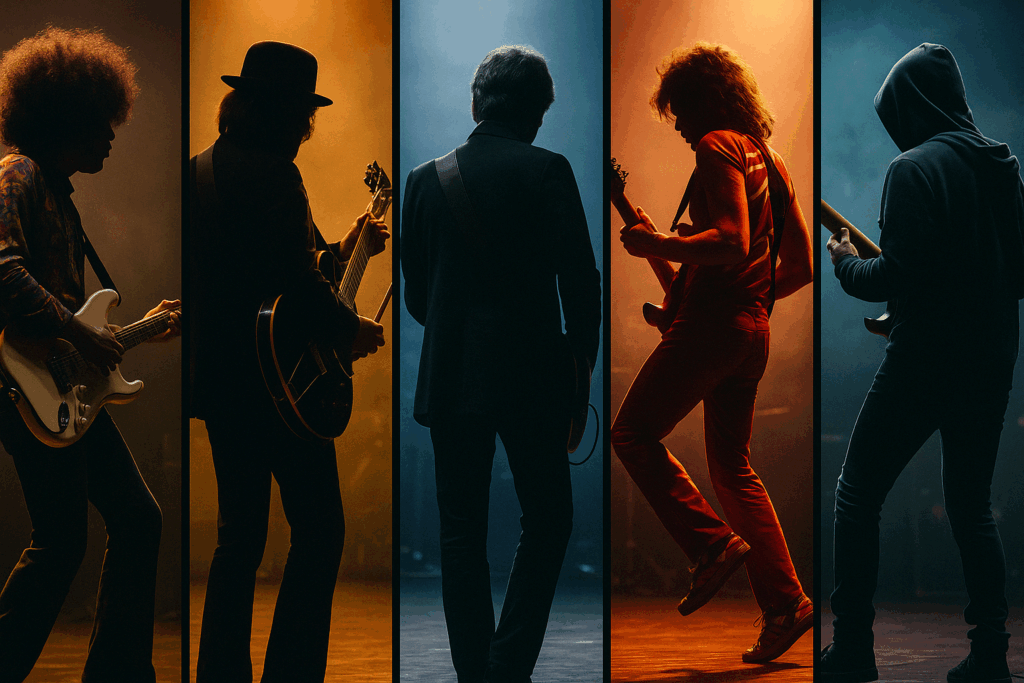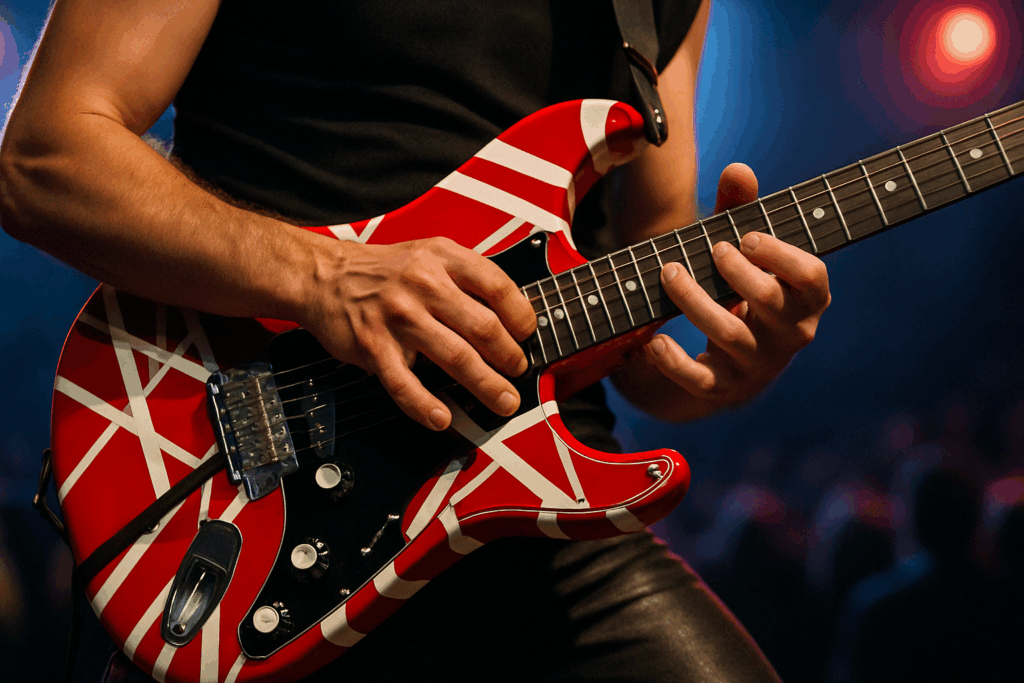
Few instruments have shaped modern music as profoundly as the electric guitar. From the moment it was amplified and brought to the forefront of rock music, the guitar has served as the primary voice of rock and roll, evolving through countless innovations that paralleled—and often drove—the evolution of the genre itself. This journey through the evolution of rock guitar traces the instrument’s development from early pioneers to today’s virtuosos, examining the revolutionary techniques and technologies that transformed how we think about music.
The 1960s: Revolution and Expression
The 1960s marked rock guitar’s true coming of age. Building on the foundational work of 1950s players like Chuck Berry, this decade saw guitarists transform the instrument into a vehicle for personal expression and sonic experimentation.
Jimi Hendrix: Rewriting the Rulebook
No guitarist changed the instrument’s trajectory more dramatically than Jimi Hendrix. His innovative use of feedback, wah-wah pedals, and the tremolo arm created entirely new sonic possibilities. Hendrix treated the guitar as a complete instrument capable of rhythm, melody, noise, and emotional expression all at once. Songs like „Purple Haze,“ „Voodoo Child,“ and his transformative rendition of „The Star-Spangled Banner“ at Woodstock demonstrated how the electric guitar could transcend its limitations to become a tool for profound artistic expression.
„When the power of love overcomes the love of power, the world will know peace.“
— Jimi Hendrix
Eric Clapton and British Blues
While Hendrix pushed boundaries, Eric Clapton pursued tonal perfection. With Cream and as a solo artist, Clapton refined blues guitar playing into a sophisticated art form. His use of the Gibson Les Paul through Marshall amplifiers created the „woman tone“—a singing, sustaining sound that became one of rock’s most emulated tones. Clapton’s playing emphasized emotion and taste over technical flash, establishing a school of guitar playing that valued expression above all else.

The 1970s: Technical Expansion
The 1970s saw rock guitar branch into multiple directions, with players expanding the technical vocabulary of the instrument while exploring new tonal possibilities.
Jimmy Page: The Riff Master
Led Zeppelin’s Jimmy Page elevated the guitar riff to an art form. Combining blues influences with folk, Eastern music, and classical techniques, Page created some of rock’s most recognizable guitar moments. His innovative use of alternate tunings, violin bows, and studio techniques expanded what was possible on the instrument. The iconic riffs from „Whole Lotta Love,“ „Kashmir,“ and „Stairway to Heaven“ demonstrate his genius for crafting guitar parts that were both powerful and memorable.
Tony Iommi: The Birth of Heavy Metal Guitar
Black Sabbath’s Tony Iommi laid the groundwork for heavy metal guitar playing. After losing fingertips in an industrial accident, Iommi created lighter-gauge strings and often tuned down to ease playing. This necessity birthed the down-tuned, heavy guitar sound that defines metal. His use of the tritone (the „devil’s interval“) and emphasis on dark, heavy riffs established a completely new guitar vocabulary that would influence generations of metal players.
David Gilmour: Space and Atmosphere
Pink Floyd’s David Gilmour took guitar in a more atmospheric direction. His soaring, melodic solos on albums like „The Dark Side of the Moon“ and „Wish You Were Here“ emphasized space, tone, and emotional resonance over speed. Gilmour pioneered the use of delay effects to create expansive soundscapes that perfectly complemented Pink Floyd’s progressive compositions, showing that guitar could create mood as effectively as melody.
The 1980s: Technical Virtuosity
The 1980s witnessed an explosion of technical virtuosity, with guitarists pushing the limits of speed and complexity.
Eddie Van Halen: The Technical Revolutionary
Eddie Van Halen revolutionized guitar technique with his two-handed tapping approach, most famously showcased in „Eruption.“ This technique allowed for unprecedented speed and new melodic possibilities. Van Halen also pioneered guitar customization, creating his iconic „Frankenstrat“ by combining elements from different guitars. His innovations influenced virtually every rock guitarist who followed, establishing new standards for technical proficiency.
„If you want to be a rock star or just be famous, then run down the street naked, you’ll make the news or something. But if you want music to be your livelihood, then play, play, play and play! And eventually you’ll get to where you want to be.“
— Eddie Van Halen
Randy Rhoads: Classical Fusion
Ozzy Osbourne’s guitarist Randy Rhoads integrated classical music influences into metal, creating a sophisticated approach that combined technical precision with classical structures. Though his career was tragically cut short, Rhoads‘ work on songs like „Crazy Train“ and „Mr. Crowley“ established a template for neoclassical metal that would flourish throughout the decade.

The 1990s: Back to Basics and New Directions
The 1990s saw a reaction against 1980s excess, with alternative rock bringing a rawer approach to guitar, while other players continued pushing boundaries in different ways.
Kurt Cobain: Raw Emotion
Nirvana’s Kurt Cobain rejected technical flash in favor of raw expression. His power chord-driven approach and dissonant solos prioritized emotional impact over technical proficiency. Cobain’s distinctive playing on songs like „Smells Like Teen Spirit“ and „Come As You Are“ showed that rock guitar could return to basics while still sounding fresh and revolutionary.
Tom Morello: The Sound Innovator
Rage Against the Machine’s Tom Morello brought DJ-inspired techniques to rock guitar. Using a toggle switch, kill switch, and various effects, Morello created sounds previously unimaginable on a guitar. His solos on tracks like „Bulls on Parade“ and „Killing in the Name“ demonstrated that innovation wasn’t just about notes—it could also be about reimagining the instrument’s sonic capabilities.
2000s to Present: Digital Revolution and Fusion
The digital era has transformed guitar playing, with new technologies enabling fresh sounds while guitarists increasingly blend influences from across rock’s history.
Digital Modeling and Extended Range
Digital modeling technology has revolutionized guitar gear, allowing players to access countless vintage and modern tones from a single device. Meanwhile, extended-range guitars with 7, 8, or even 9 strings have expanded the instrument’s range, particularly in progressive metal and djent styles pioneered by players like Tosin Abasi of Animals as Leaders.
Fusion of Eras
Contemporary guitarists often synthesize techniques and approaches from throughout rock’s history. Players like John Mayer combine blues traditions with modern pop sensibilities, while St. Vincent (Annie Clark) blends angular art-rock with electronic elements. The internet has democratized guitar knowledge, allowing players to learn from across history and combine influences in unique ways.

Key Technical Innovations
Throughout rock guitar’s evolution, several key innovations have expanded the instrument’s possibilities:
- Distortion and Overdrive: Initially an accident when amplifiers were pushed beyond their limits, distortion became essential to rock’s sound
- Effects Pedals: From wah-wah to delay to loop pedals, effects have continuously expanded guitar’s sonic palette
- Amplifier Technology: The development of high-gain amplifiers enabled new playing techniques and tones
- Guitar Design: Innovations like locking tremolo systems, active pickups, and extended range instruments have enhanced what’s physically possible
- Digital Technology: Modeling technology and digital recording have democratized access to professional guitar sounds
Conclusion: An Ongoing Evolution
The electric guitar’s journey through rock history illustrates how a single instrument can continuously evolve through technical innovation and artistic vision. From Chuck Berry’s pioneering riffs to today’s digital innovators, each generation has built upon and sometimes reacted against what came before, creating a rich tapestry of techniques and approaches.
What makes the guitar’s evolution particularly fascinating is how cyclical it often is—players frequently revisit and reinterpret older techniques through modern sensibilities. This dialogue between past and present ensures that the guitar remains a vibrant, evolving instrument that continues to be central to rock music’s development.
As technology advances and new players emerge, the guitar will undoubtedly continue to evolve in ways we can’t yet imagine. But regardless of these changes, the essence of rock guitar remains the same: a powerful tool for personal expression that connects players and listeners through the universal language of music.
